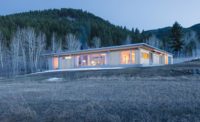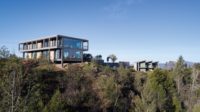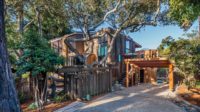Pleated House
An empty-nester couple desired a modest structure that pays 'sincere deference' to its forest site on the Door Peninsula of eastern Wisconsin.




















Architects & Firms
Door County, Wisconsin
An empty-nester couple desired a modest structure that pays 'sincere deference' to its forest site on the Door Peninsula of eastern Wisconsin. The Milwaukee firm of Johnsen Schmaling Architects responded with a simple rectangular 1,850-square-foot volume nestled in a clearing on the 4-acre property. Its charred-wood siding echoes the texture and color of the closely surrounding tree trunks. 'The challenge with this setting,' says Sebastian Schmaling, who designed the house with partner Brian Johnsen, 'is tempering the inherently disruptive act of building in nature. We made an ambiguous boundary, one that softens the geometry and moderates the transition from artificial to natural.'
The architects carved out the entrance in the rectangular mass to make a trellised forecourt that leads to the vestibule. They gave the sequence definition with walls of milled varnished lumber, stacked at slight angles that reverberate in deep relief with the board pattern wrapping the building. The vestibule connects to a covered porch in the rear, where an expansive patio extends the width of the living and dining areas.
There is a quiet tension in this sylvan retreat, by design. The interior materials'in contrast with the dark, tactile exterior'are white for walls, cabinets, and a steel staircase, with a gray polished-concrete floor. An expansive vegetated roof (which, among other green virtues, relieves runoff) visually connects the second-level master suite to the ground. Most striking is the master suite itself'a glazed and varnished-cedar-board box the red-brownish color of the entry wall and of fall foliage'expressed as an object separate from the main structure beneath it.
'This house is about a reasoned manipulation of volume and skin,' notes Schmaling. 'Rather than create form that justifies itself, we push a formal vocabulary rooted in a fundamental contextuality.'
PeopleOwner: withheld Architect: Personnel in architect's firm who should receive special credit: Interior Design: Landscape Design: Engineer: General contractor: Photographer(s): CAD system, project management, or other software used: Gross square footage: 1,840 Sq.ft. Total construction cost: withheld Completion date: 2014 |
ProductsExterior cladding Moisture barrier: Vaproshield “Wall-Shield” Roofing Green Roof: Etera Windows Doors Lift-Slide: Custom Interior Sliding Door: Raumplus Hardware Interior finishes Paints and stains: Benjamin Moore Floor and wall tile (all bathrooms): Ceramiche Caesar Lighting Exterior: Bega Dimming System or other lighting controls: Lutron Plumbing Energy Other unique products that contribute to sustainability: |















